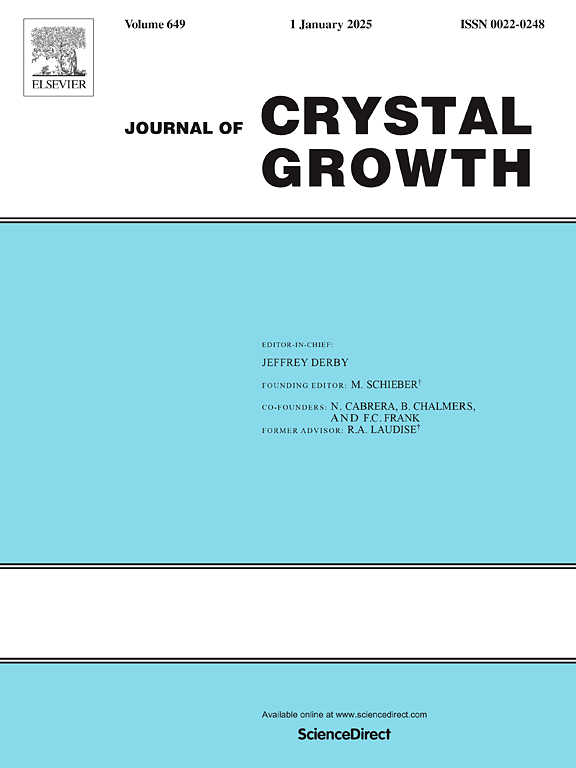Effect of substrate pretreatment on the epitaxial growth of κ-Ga2O3 layers on sapphire by halide vapor phase epitaxy
IF 2
4区 材料科学
Q3 CRYSTALLOGRAPHY
引用次数: 0
Abstract
Ultra-wide band gap semiconductor Ga2O3 emerges as a promising material for next generation high-power devices. Metastable α- and κ-phases of Ga2O3 are obtained by halide vapor phase epitaxy (HVPE) on sapphire (0001) substrates at a growth temperature of 575 °C. Substrate annealing at 1000 °C in a hydrogen or oxygen atmosphere prior to growth is critical for achieving single-crystal κ-Ga2O3 layers, as HVPE on untreated substrates results in the formation of single-crystal α-Ga2O3, as confirmed by X-ray diffraction measurements. The impact of substrate pretreatment on layer quality and phase transformation is further investigated across growth temperatures ranging from 670 °C to 970 °C. The results demonstrate that pretreatment of sapphire substrates in oxygen or hydrogen facilitates the synthesis of single crystal κ-Ga2O3, while it is unfavorable for the formation of β-phase. Cathodoluminescence measurements reveal that the κ-phase exhibits notable emission differences, with a peak maximum around ∼ 550 nm, compared to the β-phase and α-phase, which exhibit maximum emissions at ∼ 370 nm and 414 nm, respectively. Absorption measurements yield optical band gap values of ∼ 5.12 eV for the α-phase and ∼ 4.68 eV for the κ-phase. These findings provide valuable insights into controlling metastable phase synthesis in HVPE growth on sapphire.
衬底预处理对蓝宝石卤化物气相外延中κ-Ga2O3层外延生长的影响
超宽带隙半导体Ga2O3是下一代高功率器件的重要材料。在575℃的生长温度下,在蓝宝石(0001)衬底上通过卤化物气相外延(HVPE)获得了Ga2O3的亚稳α-和κ-相。在生长之前,衬底在1000°C的氢或氧气氛中退火对于获得单晶α-Ga2O3层至关重要,因为x射线衍射测量证实,未经处理的衬底上的HVPE会导致α-Ga2O3单晶的形成。在670℃至970℃的生长温度范围内,进一步研究了衬底预处理对层质量和相变的影响。结果表明:蓝宝石衬底在氧或氢条件下预处理有利于κ-Ga2O3单晶的合成,而不利于β相的形成。阴极发光测量表明,与β相和α相相比,κ相在~ 550 nm处表现出显著的发射差异,峰值分别在~ 370 nm和414 nm处表现出最大的发射。吸收测量得到α-相的光学带隙值为~ 5.12 eV, κ-相的光学带隙值为~ 4.68 eV。这些发现为控制蓝宝石上HVPE生长的亚稳相合成提供了有价值的见解。
本文章由计算机程序翻译,如有差异,请以英文原文为准。
求助全文
约1分钟内获得全文
求助全文
来源期刊

Journal of Crystal Growth
化学-晶体学
CiteScore
3.60
自引率
11.10%
发文量
373
审稿时长
65 days
期刊介绍:
The journal offers a common reference and publication source for workers engaged in research on the experimental and theoretical aspects of crystal growth and its applications, e.g. in devices. Experimental and theoretical contributions are published in the following fields: theory of nucleation and growth, molecular kinetics and transport phenomena, crystallization in viscous media such as polymers and glasses; crystal growth of metals, minerals, semiconductors, superconductors, magnetics, inorganic, organic and biological substances in bulk or as thin films; molecular beam epitaxy, chemical vapor deposition, growth of III-V and II-VI and other semiconductors; characterization of single crystals by physical and chemical methods; apparatus, instrumentation and techniques for crystal growth, and purification methods; multilayer heterostructures and their characterisation with an emphasis on crystal growth and epitaxial aspects of electronic materials. A special feature of the journal is the periodic inclusion of proceedings of symposia and conferences on relevant aspects of crystal growth.
 求助内容:
求助内容: 应助结果提醒方式:
应助结果提醒方式:


